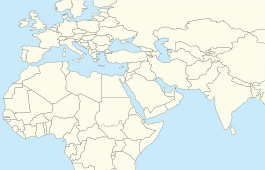| Al-Bidya Mosque The Ottoman Mosque [1] | |
|---|---|
Masjid Al-Bidyah (مَسْجِد ٱلْبِدْيَة) | |
 | |
| Religion | |
| Affiliation | Islam |
| Branch/tradition | Sunni |
| Location | |
| Location | Al-Bidiyah, Fujairah, United Arab Emirates |
| Geographic coordinates | 25°26′20.65″N56°21′14.08″E / 25.4390694°N 56.3539111°E |
| Architecture | |
| Type | Mosque |
| Date established | 15th century C.E. |
| Specifications | |
| Dome(s) | 4 |
| Minaret(s) | 0 |
Al-Bidya Mosque (Gulf Arabic : مَسْجِد ٱلْبِدْيَة, romanized: Masjid Al-Bidyah, sometimes transliterated as Al-Bidiyah (ٱلْبِدِيَة) or Al-Badiyah (ٱلْبَدِيَة)) is a historical mosque in the Emirate of Fujairah, the U.A.E. It was the oldest known mosque in the country, [2] prior to the discovery in September 2018 of the ruins of a 1000-year-old mosque dating back to the Islamic Golden Age, near the Sheikh Khalifa Bin Zayed Al Nahyan Mosque in the city of Al Ain, Emirate of Abu Dhabi. [3] [4] Still in use, it is located in the small village of Al-Badiyah or Al-Bidiyah, about 40 km (25 miles) north of the Emirate's capital city, [5] and is also known as the "Ottoman Mosque". [1] [6]




